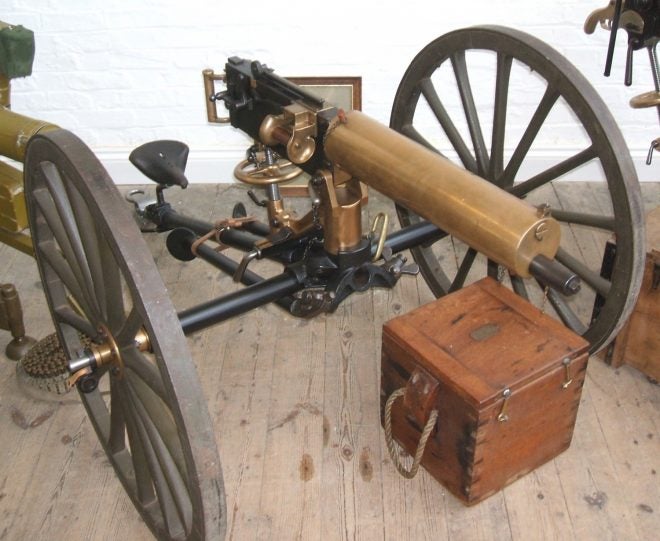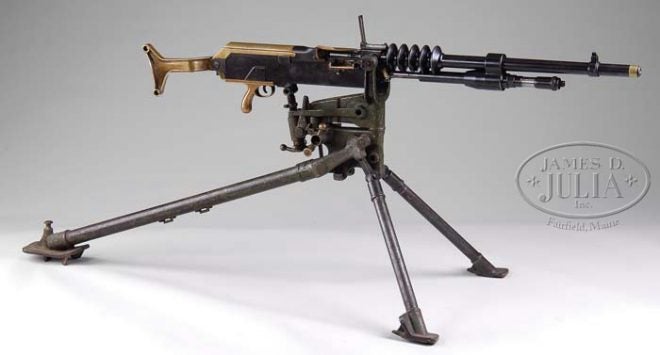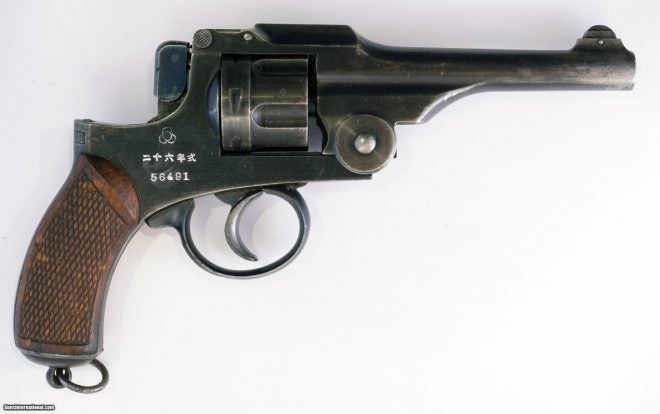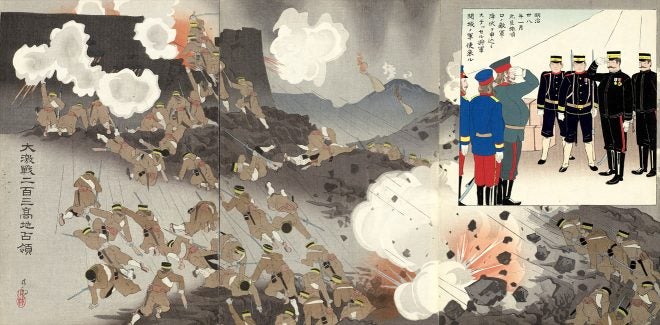Clash of empires in the east
The Liadong (Liaotung) Peninsula, China, 1904-5. The Russo-Japanese War. The Japanese are seeking to regain the use of Port Arthur and the Liadong Peninsula , given to them by the Treaty of Shimonoseki after the Sino-Japanese war. This territory was taken from them by Russian political maneuvering (aided by the French and British) in the Triple Intervention of 1895.
While the Russo-Japanese war was geopolitically significant due to the rise of Japan as a world rather than regional power, it’s technological significance was great as well. There were some machine-guns, artillery, and autocannons on both sides to be sure in the Second Boer War. This, however was the debut of both belligerents using large numbers of machine-guns, infantry guns, mines, barbed and electrical wire, and hand grenades. In this piece, we will be taking a look at early use of large numbers of machine-guns and how their employment not only affected this conflict, but preparations for WWI as well.
The Weapons
Russia:
Maxim Machine Gun, originally fielding 40 Vickers-Maxim commercial Model 1901s with Bronze Water-Cooled jacket. These were originally purchased from the British, supplemented by several hundred more in similar configuration from other sources. Though an agreement was reached with Vickers in 1902 to facilitate manufacturing in Russia, Russian Manufacture of the Maxim did not begin until 1910. All of these guns were chambered in 7.62x54mm. Russia did have some Madsen M1902 machine-guns in their armories for cavalry use, but none were sent to the Liadong Peninsula and no reports recorded their use in combat. (Edit: Thanks to one of our readers: a source reported: ” …the report completely ignored the field result of the Madsen during the Russo Japanese war at the siege of Mukhden in March, 1905, where six Russian Cavalry Madsens had fired nearly 30,000 rounds, aiding materially in repelling a major Japanese attack.”

Vickers-Maxim 1897, similar in configuration to 1901. Image credit: Forgotten Weapons
Though some Winchester lever action carbines were carried by Cossack units, the Russian rifles used at the time were overwhelmingly the “Three Line Rifle, Model 1891”, our beloved Moist Nugget.
The pistols used at the time were 1895 Nagant revolvers, in double action for officers and single action for other ranks.
Japan:
Japanese Machine-guns of the time were Odkolek-designed, Benet-Mercie improved Hotchkiss 1897s, rechambered from 8mm to 6.5x50mm. Most of their receivers were of French manufacture, although some initial manufacturing had taken place at Tokyo Arsenal by the outbreak of war. These machine-guns were given the model name “Type Ho”.

Hotchkiss M1897
Image credit: James D. Julia Auctions

M1897
The Japanese rifles of the time were Type 30 and 35 Rifles and Type 30 Carbines, all in 6.5x50mm. IJN Naval Landing Force troops still carried the 8mm Type 22 Murata rifle, and cavalry troops used the 8mm Type 22 carbine.

Type 35 Rifle, Photo Credit James D. Julia Auctions

Type 30 Rifle and Carbine, Photo Credit James D. Julia Auctions

Mishaco Offers an excellent overview of the Murata
The pistol issued at the time was the 9mm Type 26 revolver.

Type 26 Revolver
Russian Infantry weapon Tactics and employment
The Russians, while enjoying the protection of fortifications that included landmines as well as barbed and electric wire, had some serious errors in the employment of their support weapons. Russian heavy artillery throughout the campaign was routinely situated directly on top of any terrain feature they occupied and used direct fire. The Japanese, using forward observers communicating with hidden artillery used in indirect fire, were able to knock out most Russian artillery in the first ten minutes of most engagements. This dynamic led the Russians to largely depend on their machine guns and quick-firing infantry guns (most of which were the 76mm Model 1900).
These weapons were dug into very well protected positions and did imply interlocking fields of fire. Most accounts, including from foreign observers, concur that this was the primary method of employment of Russian machine guns. On the defensive, the Russians would use the machine-guns as a very short range weapon. The Russians preferred to wait until the Japanese were surprisingly close until they opened fire with their machine guns. According to Human Bullets, a firsthand account by Japanese Officer Tadayoshi Sakurai:
The Russians Regarded this machine-gun as their best friend, and certainly it did very much as a means of defense. They were wonderfully clever in the use of this machine. They would wait until out men would come very near them, four or five ken only, and just at the moment when we proposed to shout a triumphant Banzai, this dreadful machine would begin to sweep over us as if with the besom (sic) of destruction, the result being hills and mounds of dead.
A Ken is a traditional Japanese unit of measurement standardized at 1.95 meters. This means that the Russians would wait until the enemy was only 10-12 meters away from the guns before opening fire! This early doctrine of employment certainly did not require great marksmanship or gunnery skills. It did, however, inflict huge numbers of casualties on the Japanese.
When the Russians did try to counterattack and use the machine-gun in an offense, it was rare and ineffective. They would try to advance to flanking positions with their machine-guns, and such attacks were done at night. The shiny brass jackets of their Maxims and the elevated gun height due to the wheeled carriage made the machine-gun teams easy targets during the daytime. This was a lesson the British learned during the second Boer war while trying to advance with Maxims as well. An additional bane of the Russian machine gunner was that the canvas cartridge belts would distort when wet, when they would dry after being wet, or when they would freeze. All of this caused many feeding malfunctions.
As to Russian rifle marksmanship and accuracy during the siege of Port Arthur, sources from the time indicate that it was not very effective, and an insignificant source of casualties. Russian soldiers had only 20 rounds to qualify with, from a total of 125 rounds allocated per recruit for training. Marksmanship training was also conducted without combat gear on. During combat, soldiers were issued 84 rounds of ammunition for their rifles, and bayonets were to be left on at all times.
Japanese Infantry weapon Tactics and employment
In deference to their overall role of attack in the Russo-Japanese war, the Japanese primarily used their Machine-guns in the attack. The 1897 Hotchkiss guns were well suited (for the time) for this role. The Japanese did not yet have low sled-type mounts for these guns to advance with the infantry, only a taller tripod. Therefore, the machine-guns would engage in suppression fire either from light artillery positions or from the infantry line of departure. The Japanese would immediately try to move machine-guns into captured positions to prevent against counterattack.
Frequent jamming was experienced with these guns when rechambered from 8mm to 6.5mm, largely due to headspacing issues. Most of these malfunctions were FTE and occurred on average 1/300 rounds fired. Cartridges were kept oiled when in the 30 round feed tray to try and lessen this issue somewhat. Unlike the Russians, the Japanese would employ their machine-guns long range, sometimes up to 2000 meters.
By the end of the war, the Japanese also had an average of 3-6 machine-guns per regiment to create a base of fire in conjunction with infantry guns. The Hotchkiss 1897s would sometimes fire up to 1500 rounds per action, totaling 50 trays of ammunition. This suppressive base of fire was important and effective in initial engagements further up the Liaotung peninsula, and on the more open battlefields of Manchuria. In the heavily fortified areas around Port Arthur, however, Japanese artillery, rifle-fire, and hand to hand combat inflicted far more casualties on the Russians than the machine-guns used in long range suppressive fire.
The Japanese did concentrate quite a lot on individual marksmanship training at the time. Soldiers were instructed on precise aim and trigger control. According to one account, instructors would advise soldiers to “Pull the trigger as carefully and gently as the frost falls on a cold night”. Marksmanship and combat training was conducted while wearing a full combat load, including pack. The standard combat load for Japanese troops was 120 rounds of ammunition on their harness, with an additional 30 rounds carried in their backpack. 15-20 Japanese would lay down a base of rifle fire while the rest of the company would advance. On open ground with no cover, especially on the frozen fields of Mukden, Japanese infantrymen would advance carrying individual sandbags for protection using this method.
Overall Effect
By all accounts, Russian machine-gun fire, though used at very short ranges, was a devastating source of casualties for the Japanese. Casualty estimates attribute anywhere from 1/3 to 1/2 of Japanese battle casualties to machine-guns. In an initial engagement in 1904 at Nanshan Hill (the narrowest part of the peninsula), approximately 3000 Russians held off 3 entire Japanese Divisions (approximately 35,000 soldiers), primarily using 10 machine-guns on a battle frontage of less than a mile (the Russian artillery was completely destroyed early in the engagement). Russian machine guns continued to reap their deadly harvest until the capture of Port Arthur. Their deadly effect was exacerbated due to Japanese determination to stick to initial plans of attack, relentlessly attacking dug-in positions until they carried the day.

Woodblock print of the battle of Nanshan
Ivan Bloch, a late 19th-century Polish banker, and war analyst, came to the conclusion that modern weaponry made warfare impossible; namely that industrialized warfare with modern weaponry was too deadly for an attacker to emerge victorious. The Japanese did not share this attitude. General Nogi, the main commander of Japanese forces at the time, was undeterred by the carnage inflicted by machine guns. Though Japanese casualty rates were incredibly high, their eventual victory in the face of such carnage cemented their belief that Yamato Damashii would carry the day. As Tadayoshi says in his novel of the time, the Japanese soldier considered themselves as human bullets (Nikudan) of the emperor.
In their spirit of attack, the Japanese subsequently made low, easily moveable sled mounts for further iterations of their heavy machine-guns. These mounts would be easier to move, lighter, and lower in profile than the initial HO-Shiki models were, to better support infantry in the attack.
Foreign conclusions
Many foreign military observers were present on both sides to witness the debut of so many modern weapon systems on the field of battle. Conclusions were anything but unanimous, however. As to infantry tactics, Americans, British and Germans decided to implement extended-order drill and focus heavily on individual marksmanship rather than volley fire. Austria-Hungary and France ignored most of the hard-learned lessons and continued to conduct a close-order drill with dense formations. De Négrier’s attitude was that “the quality of the French soldier will overcome any technological advances on the field of battle”.
As to the employment of machine guns, the observers in the field noted that machine-guns used in attack should be lighter, individual weapons and that heavy, crew-served machine-guns were near useless for an attack. The British and Americans strangely discounted the effectiveness of machine-guns. One U.S. observer’s report even stated that machine-guns should “not be kept on the firing-line, but held in reserve”. The Germans were most impressed of all at the effectiveness of machine-gun fire. At the outset of World War I less than a decade later, the Germans had 4,900 vs 2,500 French and only 108 British. The rest is history.
For more information on the weapons of the time period, please check out:
Our friend Ian at Forgotten Weapons
Sources:
Sakurai, T., & Honda, M. (1906). Human bullets (Niku-dan). Tokyo: Teibi Pub.
Sisemore, Maj. J. D. (2012). The Russo-japanese war, Lessons Not Learned. Pickles Partner Pub.
Jowett, P. S., Ivanov, A., & Karachtchouk, A. (2004). The Russo-Japanese War 1904-05. Oxford: Osprey.
 Your Privacy Choices
Your Privacy Choices
